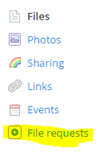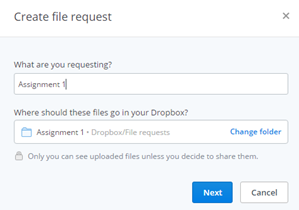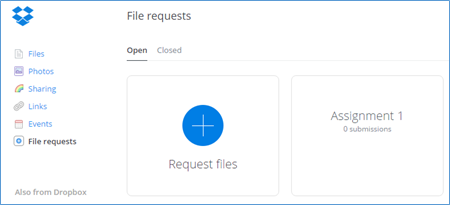![]() Once upon a time, there was a third party service for Dropbox called DropItToMe. It allowed others to upload files to your Dropbox account. That service went extinct some time ago, but the programmers at Dropbox have been working on creating that functionality inside of Dropbox itself. And it is now available. The feature is called “File requests”. Give people a URL, and when they visit that URL, they will be able to upload a file as big as 2 GB (I think) to your Dropbox account. How cool is that? And, of course, once the file arrives is uploaded to Dropbox.com, Dropbox will sync it with all of your devices where you have Dropbox installed.
Once upon a time, there was a third party service for Dropbox called DropItToMe. It allowed others to upload files to your Dropbox account. That service went extinct some time ago, but the programmers at Dropbox have been working on creating that functionality inside of Dropbox itself. And it is now available. The feature is called “File requests”. Give people a URL, and when they visit that URL, they will be able to upload a file as big as 2 GB (I think) to your Dropbox account. How cool is that? And, of course, once the file arrives is uploaded to Dropbox.com, Dropbox will sync it with all of your devices where you have Dropbox installed.
 To access this feature, log into your Dropbox.com account via your web browser. On the left, click on “File requests”. Click the big blue button “Create file request”.
To access this feature, log into your Dropbox.com account via your web browser. On the left, click on “File requests”. Click the big blue button “Create file request”.
The pop-up window asks where you want the files to go. Dropbox will create a new folder aptly-named “File requests” in your root Dropbox folder. When y ou write something in the required “What are you requesting” field, like “Assignment 1”, Dropbox will create a new subfolder called “Assignment 1” that will reside inside of the “File requests” folder. If you already have a Dropbox folder location in mind, say, in an assignment subfolder that resides in your course folder that resides in your academic year folder, you can click “change folder”, and Dropbox will show you all of your folders. Pick the once you want.
ou write something in the required “What are you requesting” field, like “Assignment 1”, Dropbox will create a new subfolder called “Assignment 1” that will reside inside of the “File requests” folder. If you already have a Dropbox folder location in mind, say, in an assignment subfolder that resides in your course folder that resides in your academic year folder, you can click “change folder”, and Dropbox will show you all of your folders. Pick the once you want.
Click “Next” to get the link. You can either just copy the link or you can enter email addresses of those you want to receive the link and let Dropbox contact them.
Now when you click on “File requests” you will see your open and closed file requests. Clicking on “Assignment 1” opens my “Assignment 1” folder in Dropbox. Mousing over it gives me two options. I can edit it, which essentially takes me back to the “Create file request” pop-up window where I can change the folder, although there is one additional option on this screen now; I can also close the link. Closing the link means that even when someone visits the URL, they will not be able to upload a file. The second mouse-over option allows me to add more people; this takes me back to the second pop-up where I got the link allowing me to copy the link again or enter more email addresses for Dropbox to send the link to.

Click “Request files” if you want to create more. If you have different courses or sections with different assignments, create a file request for each one. If you’re picturing having to move files once they’ve been uploaded, set things up on the front-end so that Dropbox does the sorting for you.
What does the person who visits your file request URL experience?
They will be asked to navigate through their computer’s file structure to identify the file they want to upload. And then they will be asked for their first name, last name, and email address. They can even add more files to upload. Dropbox will append the person’s name to the beginning of the filename. Let’s say that Charlie Brown uploads a file he named “Assignment 1.docx”. The file will be renamed “Charlie Brown – Assignment 1.docx”.
What happens to the email address the person entered when uploading? Dropbox uses it to send the person a message saying that their file has indeed been uploaded.
And you, as the person requesting files, will receive an email informing you that a file has been uploaded along with the name of the file and a link to access the file on the Dropbox website.
Quick recap of Dropbox download/upload features
Two-way street (download and upload). If you share a folder with someone, both you and that someone can manipulate the files in that folder; what’s yours is theirs and what is theirs is yours.
One-way street toward downtown (download only). If you create a link to a folder or file, anyone who has the link URL can download the files in the folder or that individual file; they cannot make changes to your folder or file that resides in Dropbox.
One-way street toward uptown (upload only). If you create a file request, anyone who has the URL can upload files to the Dropbox folder you designate; they cannot see or download any of your Dropbox files.
Conclusion
If the occasional person emails you a file, then there’s no need to use this feature. If you have a bunch of people emailing you files that you’re just going to add to Dropbox anyway, why not skip the email middle-man and just have them add their file directly to your Dropbox account?

